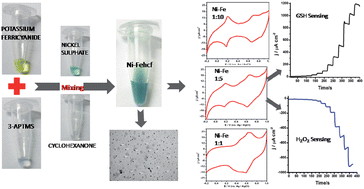Cyclohexanone and 3-aminopropyltrimethoxysilane mediated controlled synthesis of mixed nickel-iron hexacyanoferrate nanosol for selective sensing of glutathione and hydrogen peroxide†
Abstract
We report the

* Corresponding authors
a
Department of Applied Chemistry, Indian Institute of Technology (BHU), Varanasi-221005, India
E-mail:
pcpandey.apc@iitbhu.ac.in
Fax: +91 542 2368428
Tel: +91 9415813018
We report the

 Please wait while we load your content...
Something went wrong. Try again?
Please wait while we load your content...
Something went wrong. Try again?
P. C. Pandey and A. K. Pandey, Analyst, 2013, 138, 952 DOI: 10.1039/C2AN36228G
To request permission to reproduce material from this article, please go to the Copyright Clearance Center request page.
If you are an author contributing to an RSC publication, you do not need to request permission provided correct acknowledgement is given.
If you are the author of this article, you do not need to request permission to reproduce figures and diagrams provided correct acknowledgement is given. If you want to reproduce the whole article in a third-party publication (excluding your thesis/dissertation for which permission is not required) please go to the Copyright Clearance Center request page.
Read more about how to correctly acknowledge RSC content.
 Fetching data from CrossRef.
Fetching data from CrossRef.
This may take some time to load.
Loading related content
